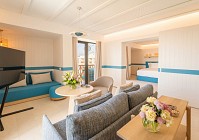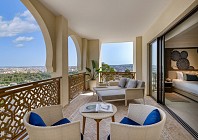The aroma of freshly tanned leather and cinnamon-infused pastries wafts through the air as I run my hand over the fringing of a colourful rug. The warp and weft of Morocco’s soul, the practice of carpet weaving dates back to the Paleolithic period here. It’s a practice that’s been honed over many centuries by Amazigh (Berber) women from rural communities in the Atlas Mountains. In the former imperial city of Marrakech, women-run carpet cooperatives are part of the fabric of its medina: a human honeycomb wrapped by 12-miles of millennia-old pink walls.
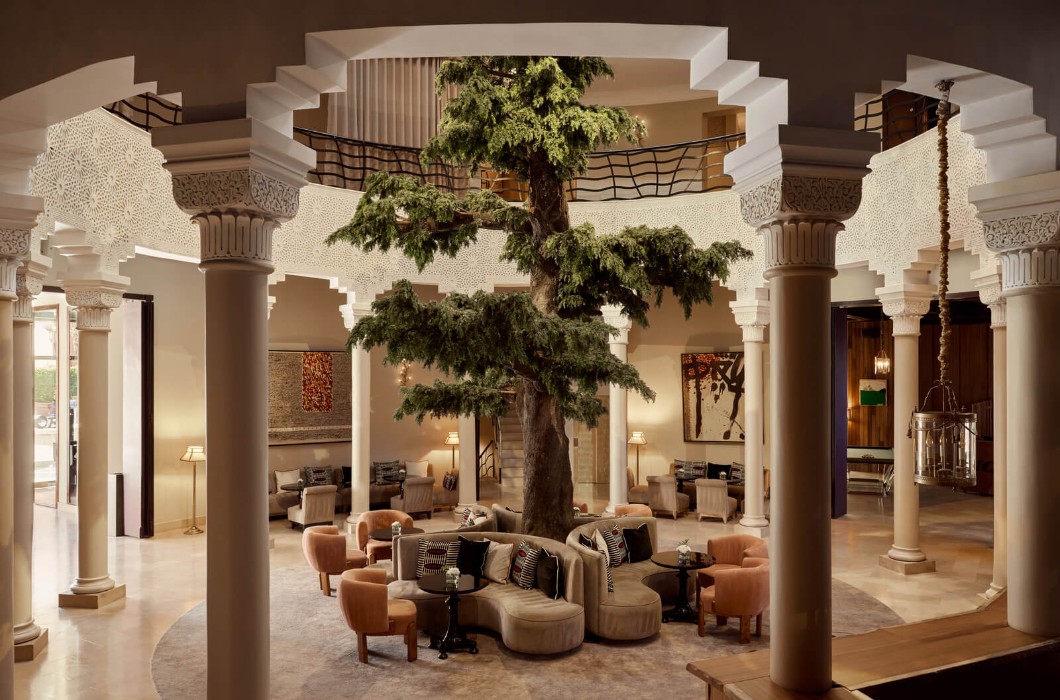
You’d be hard-pressed to find a better place to drink in a stork’s-eye-view of the city’s ramparts than Nobu Hotel Marrakech. Its 360-degree rooftop deck crowns a striking spherical red building sheathed in a latticed steel skin. The suite-only property plants guests a 20-minute walk from the medina’s famed and frenetic Jemaa el-Fnaa Square, whilst keeping good company in the fashionable Hivernage neighbourhood, built for French diplomats during the 1930s. Opened in early 2023, the hotel is the Robert De Niro, Nobu Matsuhisa and Meir Teper-owned chain’s first African outpost. You could happily spend an entire day watching the sun dance across the Atlas Mountains from its beach-club-styled rooftop cabanas and teardrop hanging chairs.
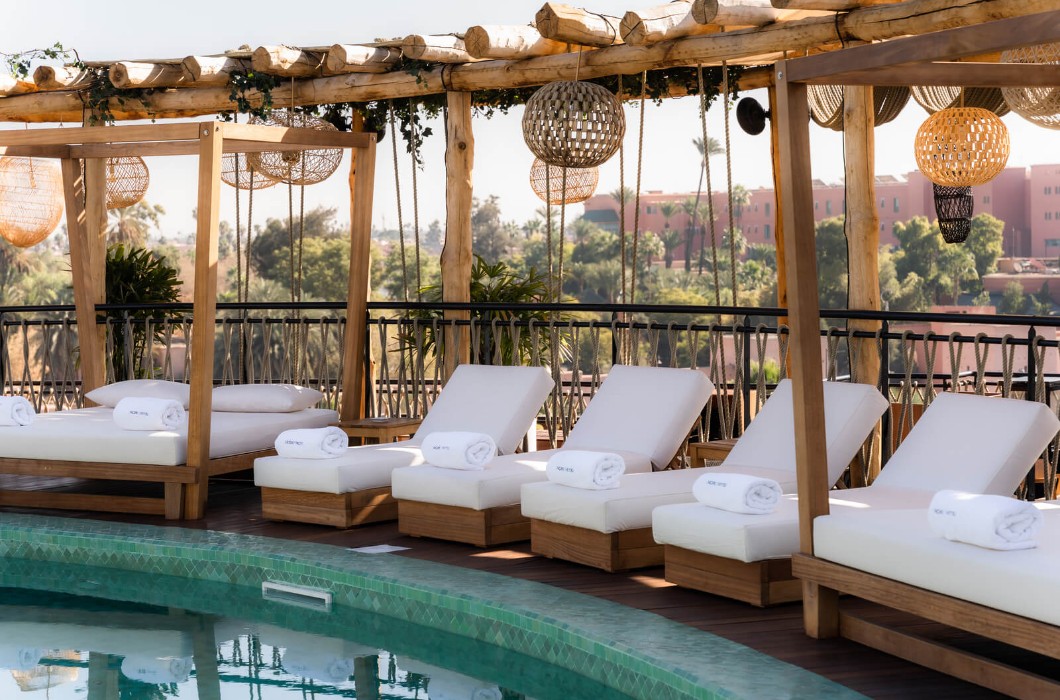
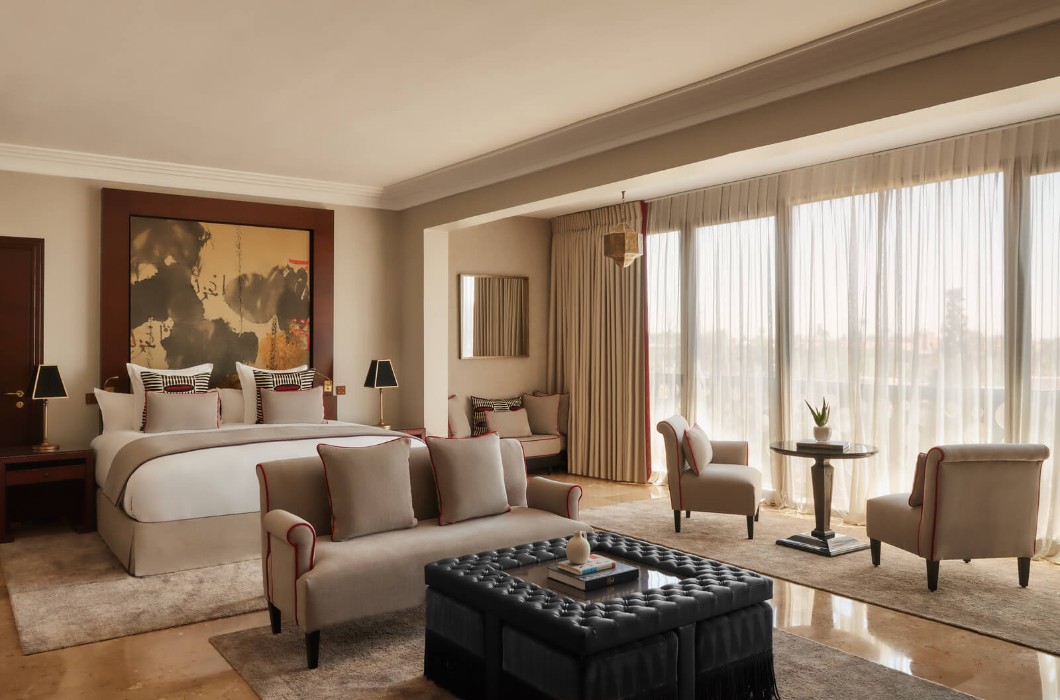
Inside, the property’s design-forward Japanese minimalism comes to the fore. Guests are welcomed by a giant Bonsai tree that reaches for the third floor of the hotel’s showstopping central rotunda. It’s here that teatime Moroccan pastries and an elaborate breakfast fit for a sultan are served, spilling out onto the hotel’s sit-out terrace complete with a sun-dappled swimming pool.
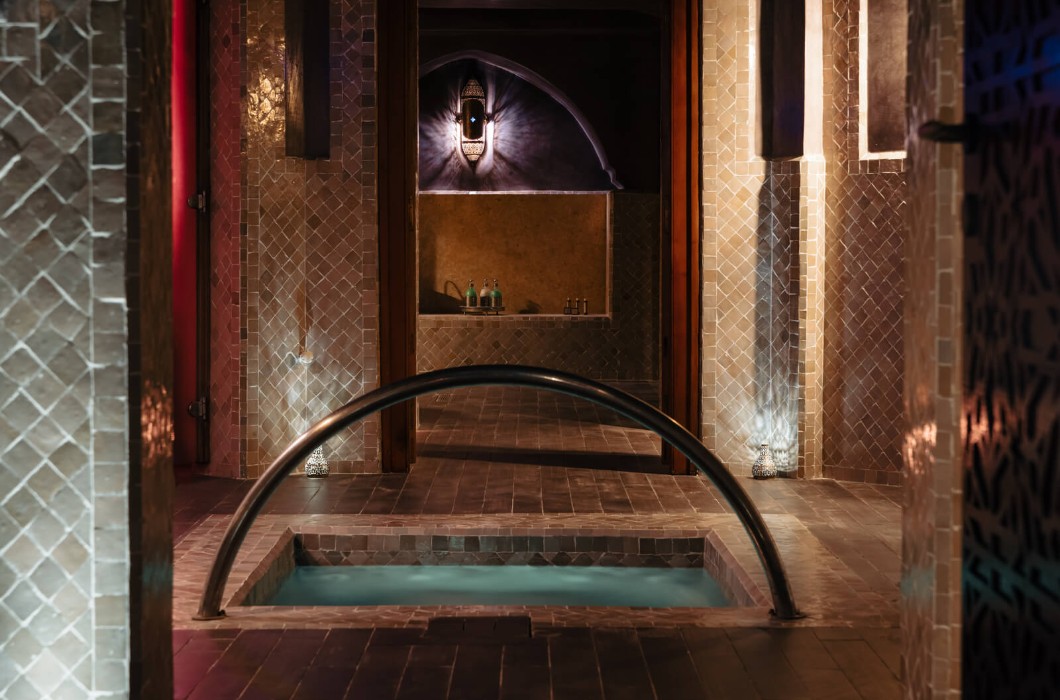
The largest of the hotel’s three pools is located in its lantern-lit 2,000-sqm subterranean Pearl Spa, where Asian modernity meets Moroccan heritage. My appetite piqued after sweating it out in the hammam, I make a dinner date with the hotel’s namesake ground floor restaurant, which vaunts a private entrance. Beneath a faux maple leaf ceiling I graze on yellowtail sashimi with jalapeño and black cod miso from its Japanese-Peruvian menu curated by Nobuyuki “Nobu” Matsuhisa. The celebrity chef’s signature plates are complemented by Moroccan-inspired dishes like crispy artichoke argan oil salad and vegan carpaccio. The evening promises plenty of theatrics thanks to a troupe of sequinned fan dancers and chefs who work their sushi magic from the open kitchen, which spans the entire width of the restaurant.
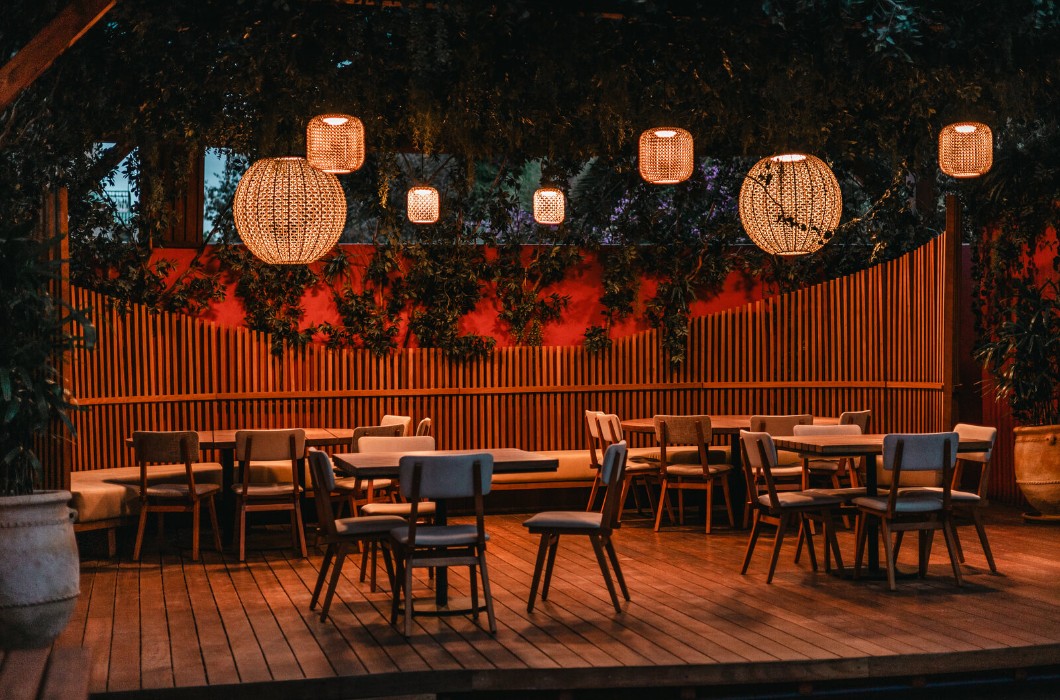
Stuffed to the gills, I retreat to my Deluxe One-Bedroom Balcony Suite, which draws inspiration from both Japanese and Moroccan culture. A textural delight: leather upholstered walls, teak accents and tasselled furniture are washed in aubergine, taupe and beige hues. Swapping Marrakech’s adobe-walled medina for Rabat’s wedding white kasbah, I journey north to Morocco’s Atlantic-spritzed coast, reached via a 3.5-hour train ride. Founded in the 12th century, the country’s fortified capital — where exiled moors once sought refuge — is said to be the greenest city on the continent. Its glorious mash-up of Islamic, French colonial and futuristic architecture helped crown Rabat the first African Capital of Culture in 2022. A year later marked the grand unveiling of its Grand Theatre, dubbed the largest performing arts complex in Africa and the Arab world. Masterminded by the late Pritzker prize-winning architect Zaha Hadid, its fluid sculptural form echoes the curve on the Bou Regreg River on which it sits.
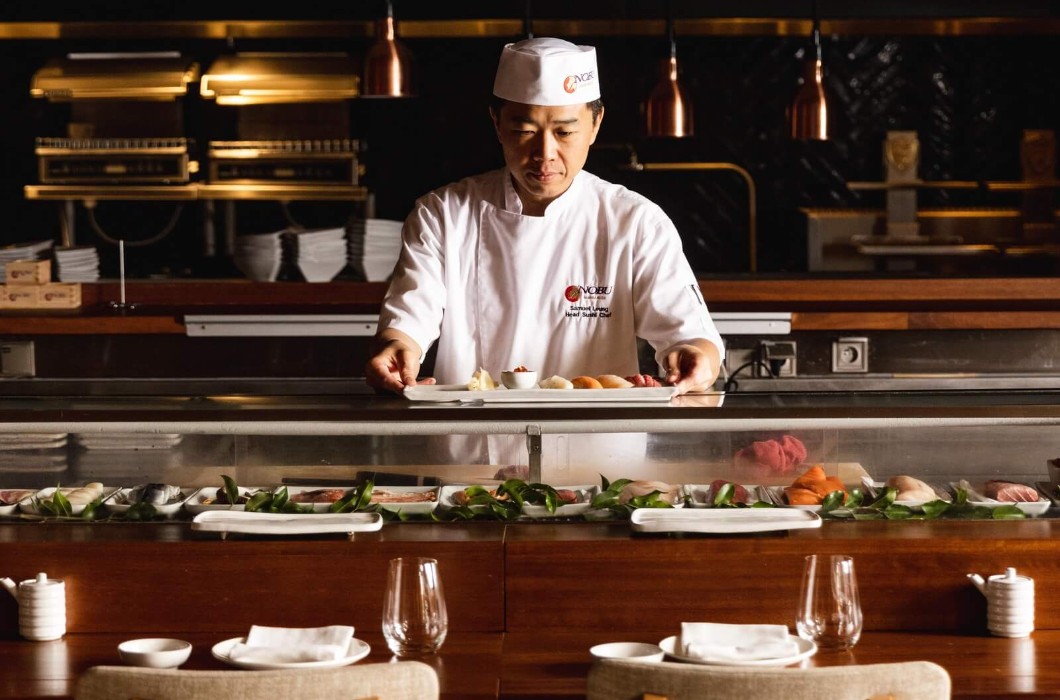
Nestled at the mouth of the river — which separates Rabat from its sister city of Salé — is my next five-star check-in: the Fairmont La Marina Rabat Salé Hotel & Residences. Opened in late 2022, the property’s striking façade mimics an ocean cruise liner that’s dropped stylish anchor in the Atlantic. After a waggy-tailed welcome from the hotel’s Golden Retriever, Tiffany, I’m ushered into its glass-domed lobby, which recalls the light-filled patio of a Moroccan riad. Under the shadow of 340 (crystal-cut) albatross wings, I indulge in a welcome platter of walnut-stuffed Moroccan dates washed down with orange blossom-fragranced almond milk. Between its clean lines and monochromatic colour scheme, one could be forgiven for thinking that tradition has been snuffed out. But the hotel pays homage to its locale in numerous ways. Rabat’s famed Hassan Tower — a red-stone minaret that looms 44 metres above a ruined mosque — has informed its chiselled wood panels and friezes. Meanwhile, lining its lobby-lounge-cum-tearoom, are cabinets displaying Moroccan textiles and fine jewellery.
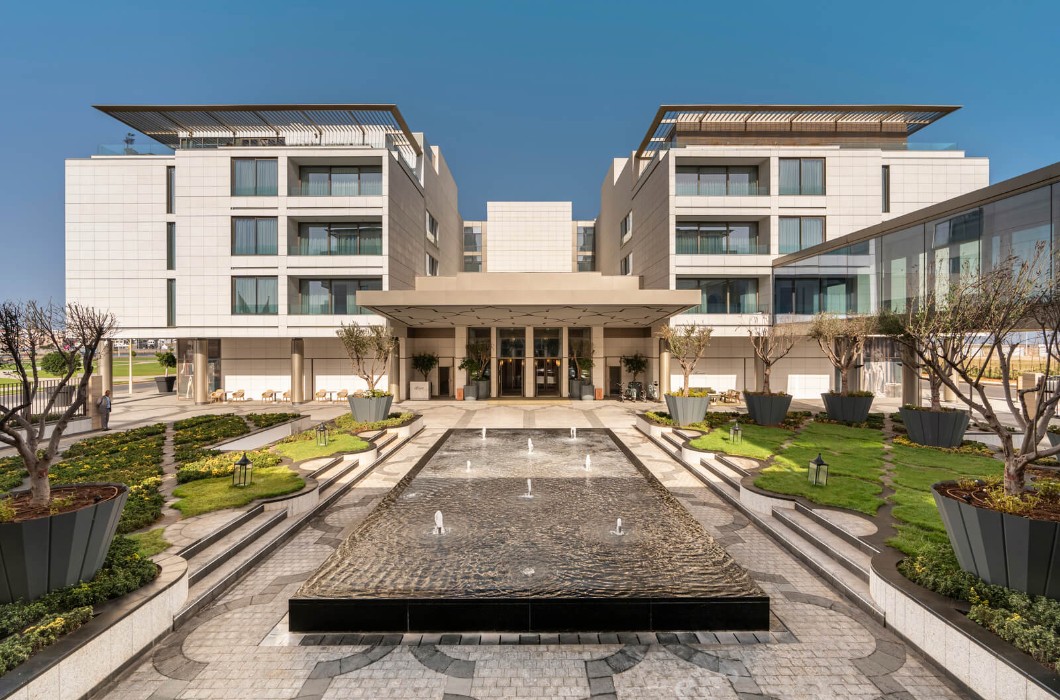
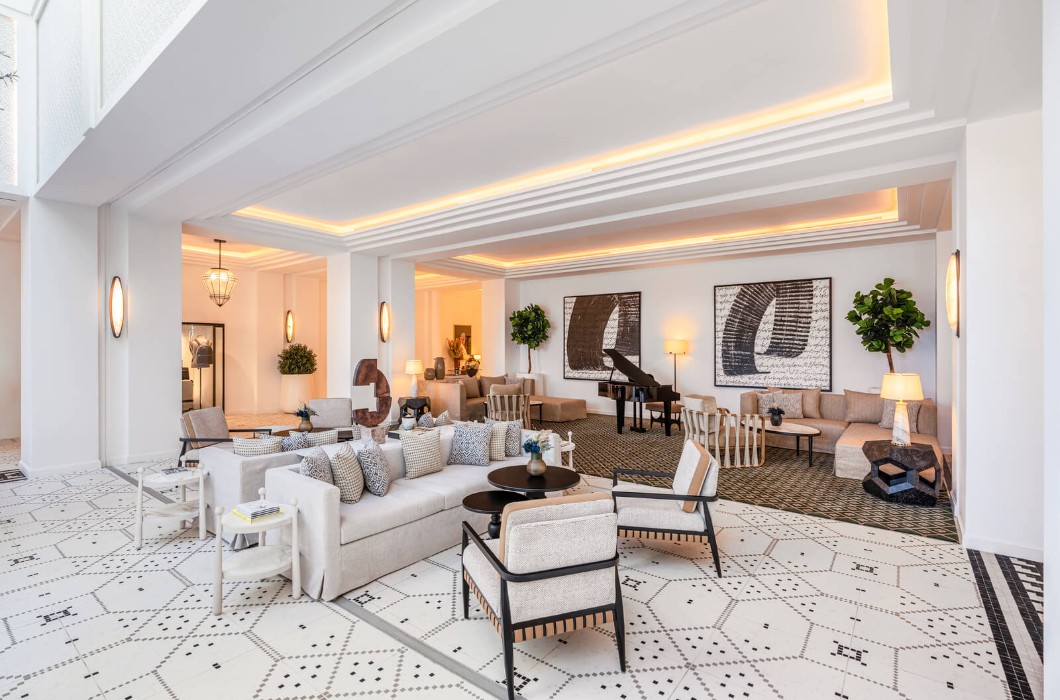
The 186-room property’s startling white interior is a love letter to the labyrinth laneways and houses of Rabat’s UNESCO-listed, cliff-clinging citadel. Also referred to as the Kasbah of the Udayas, I watch the last rays of sunshine bathe it in a golden glow from the hotel’s rooftop restaurant. Four floors down, diners can people-watch from the hotel’s Moroccan-Mediterranean fusion restaurant, Le Dahlia, which overlooks Salé’s riverfront promenade. Its beef and prune tagine is so tender that the meat falls apart at the mere touch of my fork. It pairs perfectly with a glass of velvety red from the hotel’s own vineyards in Zaërs, considered one of Morocco’s best wine-growing regions.
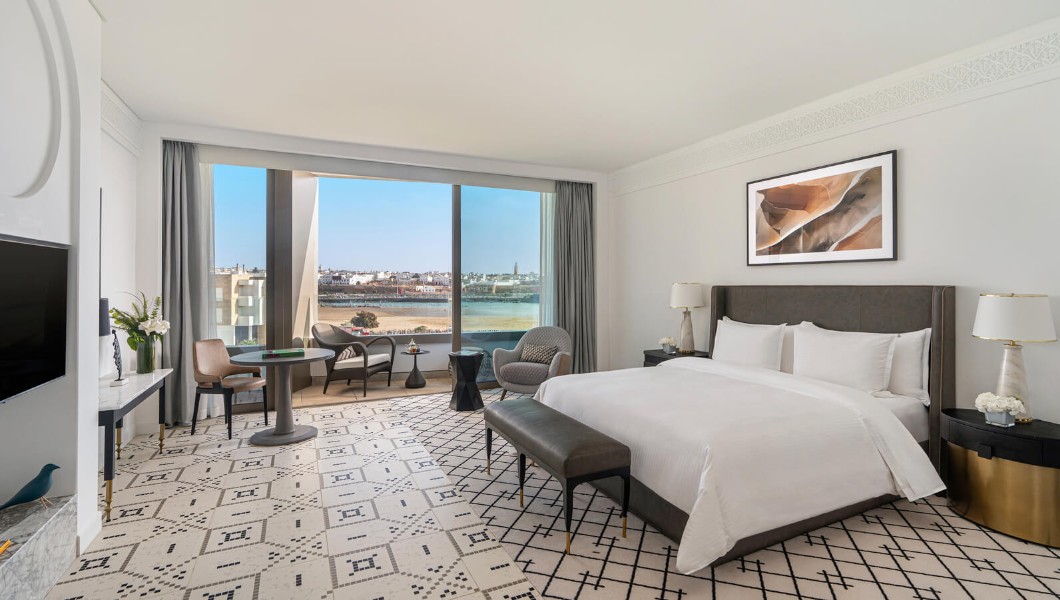
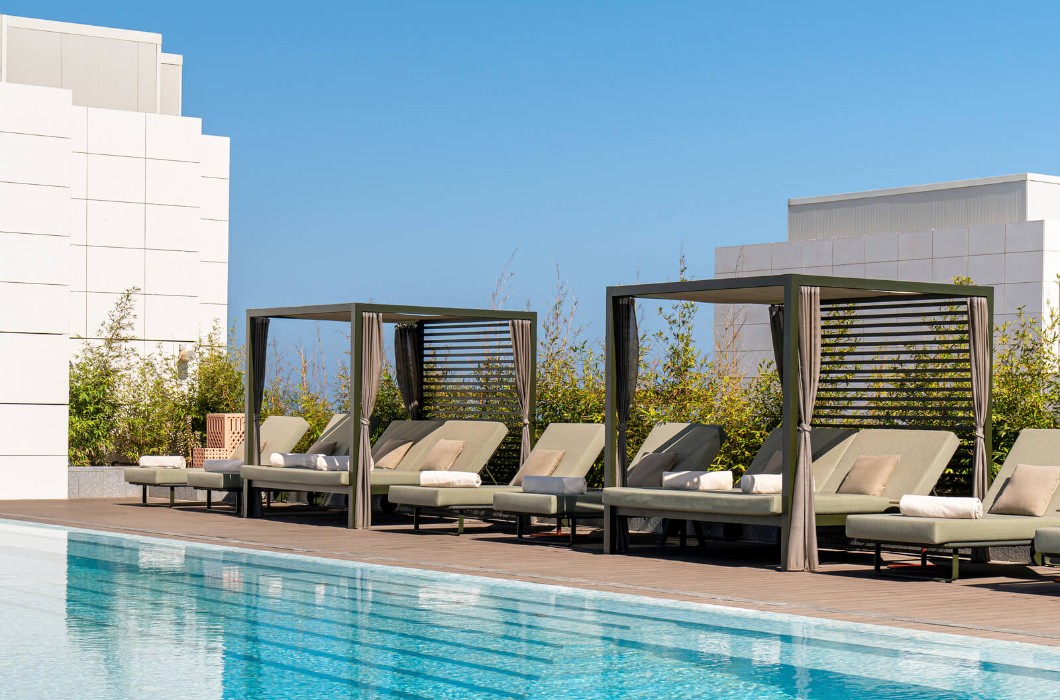
Setting me up for sightseeing the next morning is a smorgasbord-style breakfast devoured on my Ocean Suite’s sprawling 43-sqm terrace. From this mod eyrie I watch a fleet of floukas (parasol-shaded wooden water taxis) drift like paper play boats across the Bou Regreg River estuary to Rabat proper. A journey lasting only a few minutes, passengers are disgorged a stone’s throw from the city’s blissfully unhurried 13th century medina. Tucked away in the nearby lemon and rose-perfumed walled Andalusian Garden’s is the Moroccan National Adornment Museum, which reopened last January after a major overhaul. As well as displaying the world’s oldest jewellery — a 150,000-year-old snail shell necklace discovered in a cave in southwestern Morocco — it houses His Majesty the King Mohammed VI’s 3,500-piece Amazigh jewellery collection.
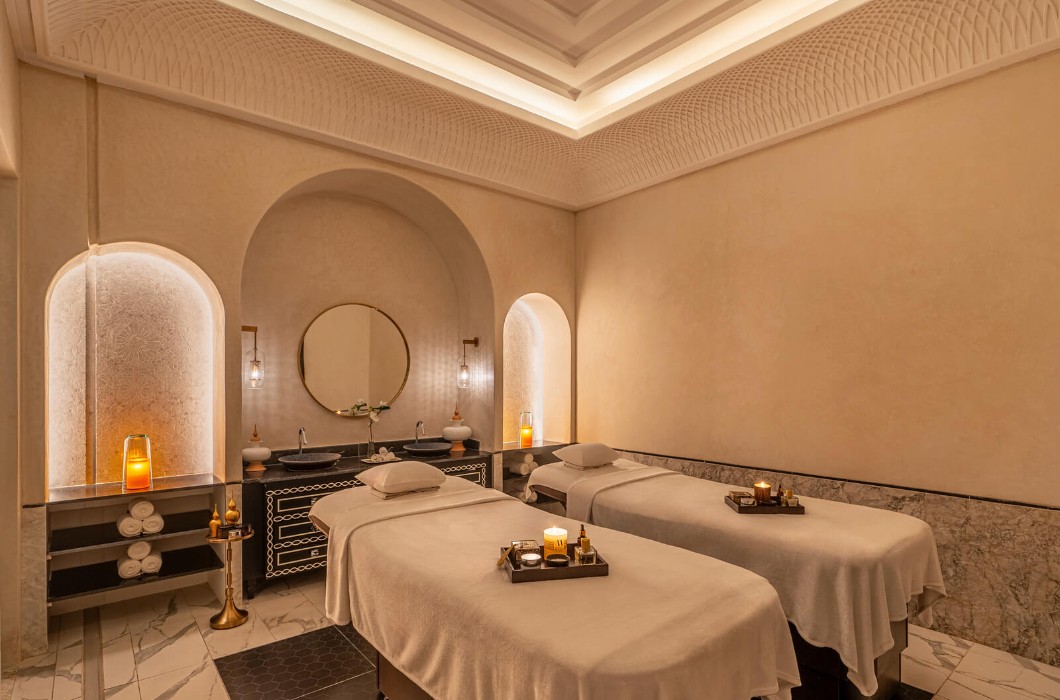
-ihcm41.jpg)
Also on show are an ensemble of traditional wedding outfits, full ornamental headdresses and antique caftans; a remarkable testament to Morocco’s rich artistic heritage. The third and final part of this Moroccan triptych sees me burying my feet squarely in the sands of Mediterranean-kissed Tamuda Bay. The pearl of the ‘Moroccan Riviera,’ it’s located to the east of the Strait of Gibraltar in a region suffused with Spanish, Roman and Moorish flavours. The nearest metropolis is Tetouan, whose whitewashed buildings have earned it the nickname: ‘The White Dove’. One of Tamuda Bay’s most coveted beachside addresses is The St. Regis La Bahia Blanca Resort, Tamuda Bay: an all-balconied 100-key property that made its debut in November 2023.
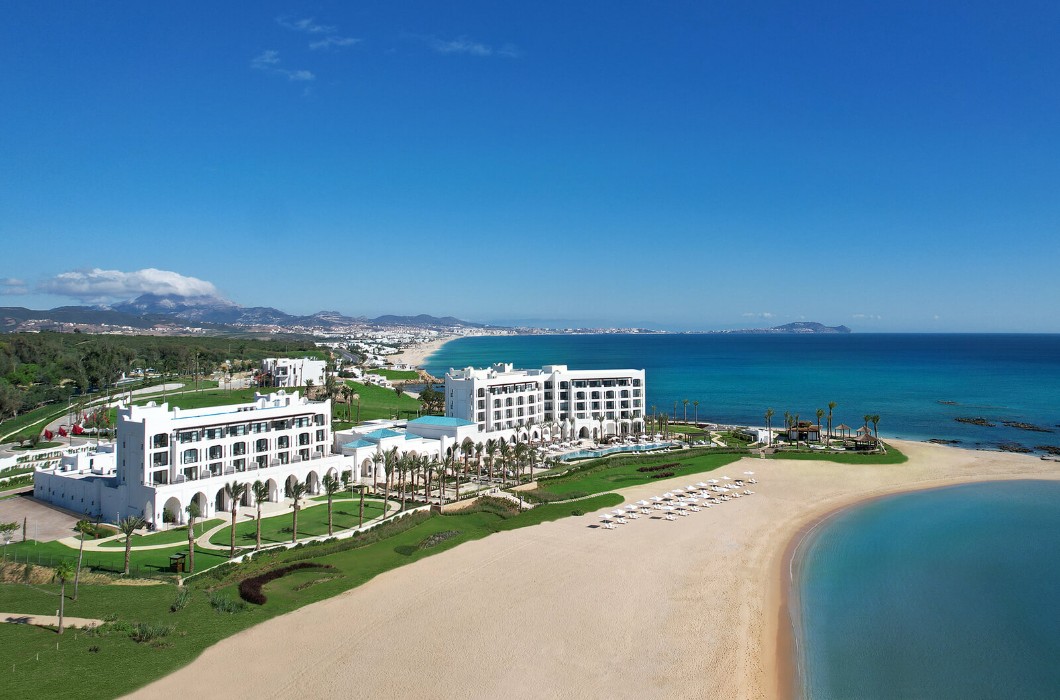
Framing dreamily turquoise waters is its towering arched entrance, which leads through to a cabana-ringed swimming pool that mimics the Rif Mountain range in the distance. Similarly rooted in place is my luxurious St. Regis Junior Suite, decorated in a calming coastal colour palette of sand, aqua and white. Saving a barefoot stroll on the resort’s shell-strewn golden beach for later, I savour a welcome pot of fancifully poured mint tea in the hotel’s colonnaded lobby, which opens out to a series of interconnected indoor-outdoor rooms; a sort of contemporary riff on traditional riad design. Ornamenting one wall of the hotel’s seafood-centric Baie Blanche Brasserie is an emerald green mosaic artwork. No ordinary zellige (handcrafted Moroccan clay tiling), it’s a rare example of the Tetouan Zellige technique. Bent on safeguarding this endangered artform is award-winning multidisciplinary artist Amine Asselman.
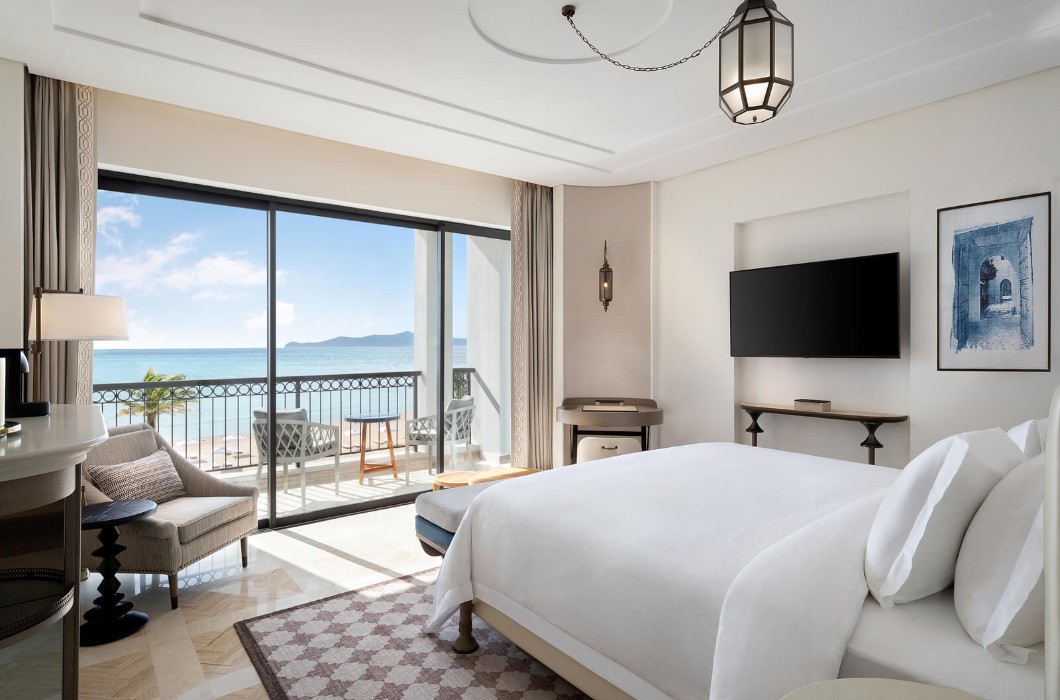
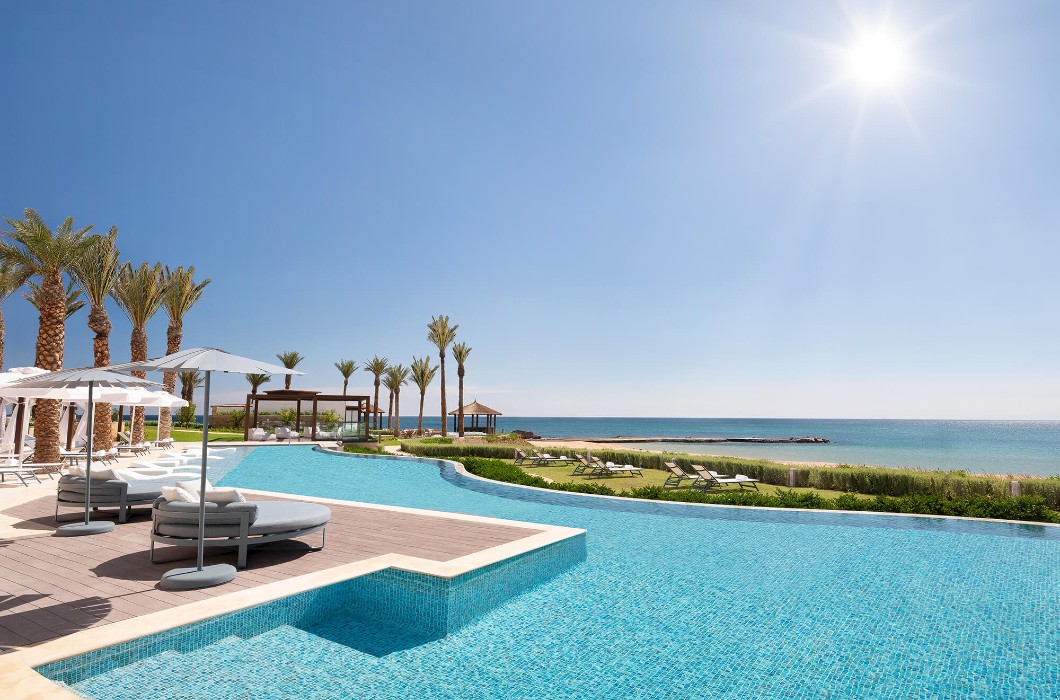
One of his botanical murals backdrops a cosy banquette in The St. Regis Bar, which serves all-day sandwiches and a Moroccan inspired twist on the classic Bloody Mary. I forgo the harissa-spiked cocktail for their newly launched afternoon tea, created in collaboration with blogger Yasmina Olfi of Fashion Mintea. Tiered cake stands arrive laden with sweet treats like passion fruit macarons, orange blossom briouates (Morocco’s version of Indian samosas) and a Tarte au Citron de Tanger inspired by Olfi’s grandmother’s recipe. They’re paired with a series of special iced teas that include a refreshing ‘Tamuda Rose.’

Another of the hotel’s female Moroccan muses is Sayyida al Hurra, a formidable 16th-century pirate-queen who ruled Tetouan for three decades. If you can peel yourself off your sun lounger or velvet banquette, an excursion to ‘The White Dove of the Mediterranean Sea’ comes highly recommended. Set at the foot of the Rif Mountains, Tetouan was occupied by the Spanish for almost two centuries. A must-see is its train-station-turned Museum of Contemporary Art (CAMT) in the city’s El Ensanche Quarter. Just a taxi hop away is the prestigious Royal Artisan School (also known as Dar Sanaa), founded during the Spanish occupation.
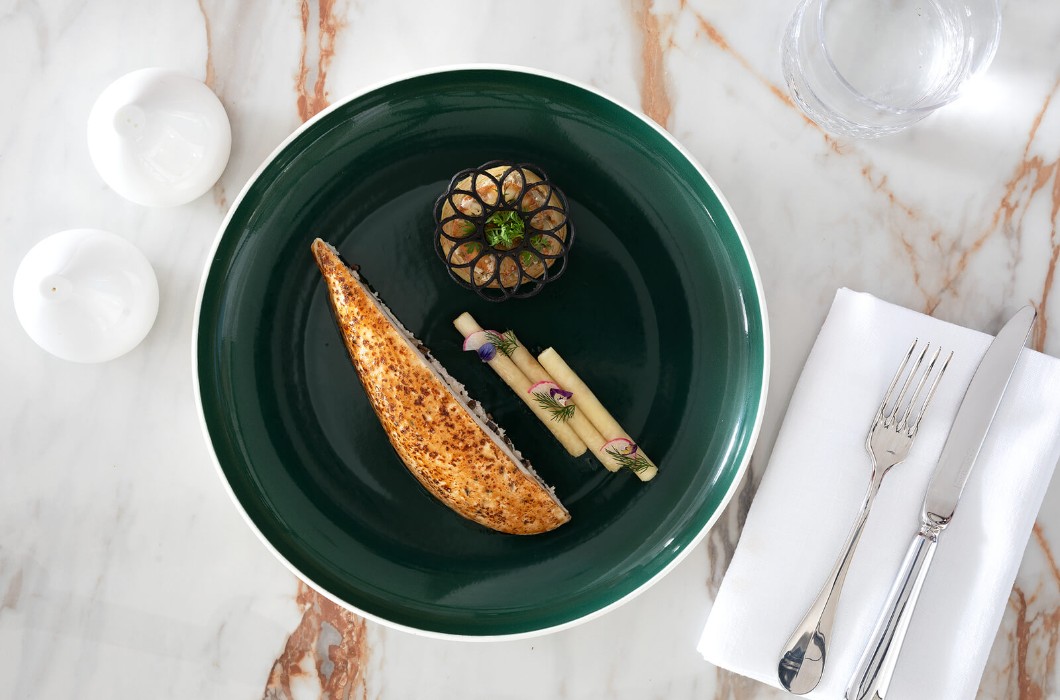
A work of art in its own right, the Hispano-Moorish building is a vision of stained glass, ornamental woodwork and Kufic inscriptions. Green Olive Arts hosts private three-hour tours of its workshops led by American expats and artists Jeff McRobbie and Rachel Pearsey. I gaze in awe as a student taps filigree into a handmade box whilst a master artisan works an ancient loom. In a full-circle moment that takes me back to those first meanderings in Marrakech’s medina, the scent of soft leather tanned only a few miles away tickles my nostrils. It’s a fittingly fragrant finale to this country of gloriously interwoven cultures.
Nobu Hotel Marrakech
+212 5244-24242
www.marrakech.nobuhotels.com
Fairmont La Marina Rabat Salé Hotel & Residences
+212 5378-20800
www.fairmont.com/rabat/
The St. Regis La Bahia Blanca Resort, Tamuda Bay
+212 539-666060
www.marriott.com








